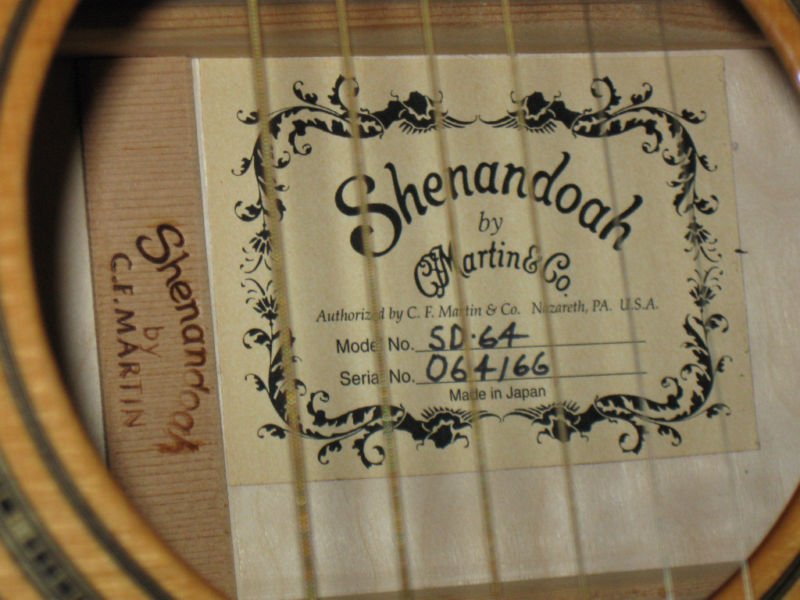A special note about dating Shenandoah guitars:
For the first 8 years or so, subassemblies comprising complete necks and complete bodies were manufactured in Japan and shipped “in the white” (unfinished) to the Martin factory in Nazareth, Pennsylvania for final assembly and finishing. All of the guitars bearing the Shenandoah brand after late 1992 were manufactured, assembled, and finished entirely in Japan. There are two simple ways to distinguish between the two
The first and most obvious way is to look at the label. Guitars assembled in the USA from Japanese-made parts will (hopefully) have a label clearly visible through the soundhole that states this clearly
These instruments will have 6-digit Serial numbers that follow the same scheme used by C.F. Martin & Co since the 19th Century, which makes it simple to determine what year a particular guitar was finished and released for sale
Martin serial number charts are widely available on the internet and elsewhere
Most of the instruments built after 1992 or so had paper labels that clearly stated “Made in Japan”. I have a pic in my files that shows one exception to this but it it rare in comparison. Most of these later MIJ instruments also have either a serial number with an “S” prefix and 6 digits (early MIJ) or a serial number made up of more than 6 digits (late MIJ), however this is not a hard-and-fast rule either. For example, the serial number shown shown in the pic below is somewhat uncommon because it does not have the usual letter prefix, however it is otherwise typical of the first run of MIJ Shenandoahs. Regardless, there are two simple ways to tell that this particular guitar was made entirely in Japan. First, because the label states this clearly in small but perfectly legible text, just beneath the serial number. The second method is more subtle, and requres a bit of effort. Using the Martin serial number list, this six digit number decodes to the year 1958 and that date is more than 20 years prior to the first Shenandoah being sold anywhere in the world. From this , and other examples of the MIJ instruments , it seems clear that when Martin stopped assembling parts in-house and shifted production entirely to Japan they also stopped assigning regular Martin serial numbers to them
And one last thing….
To date, the highest known price ever paid for a Shenandoah guitar was for a left-handed D-2832 formerly owned by David Gilmour, and sold at auction in 2019
The final selling price when the hammer dropped was $50,000 ——- Source
The second-highest known price ever paid for a Shenandoah guitar was for a 000-28323 formerly owned by Eric Clapton, which was sold at auction in 1999
The final selling price when the hammer dropped was $24,150 ———- Source
An unknown quantity of MIJ guitars were apparently made for the Japanese home market which showed the same Shenandoah brand stamp as the preceding type, but no paper label or peghead logo. Instead, a Martin-style flowerpot inlay covers the entire peghead face. The model and serial numbers are stamped on the neck block, in ink. To date, there is no known way of dating this type
The last of the guitars marketed under the Shenandoah name were significantly different in may ways from their predecessors. These guitars had a radically different logo on the peghead and the paper label changed to a completely different design. This paper label will show a Model number and a serial number with a CY prefix followed by an 8 digit number. Like the previous Type 2 and Type 3 guitars, there is no known way to date Type 4 guitars from the serial number








